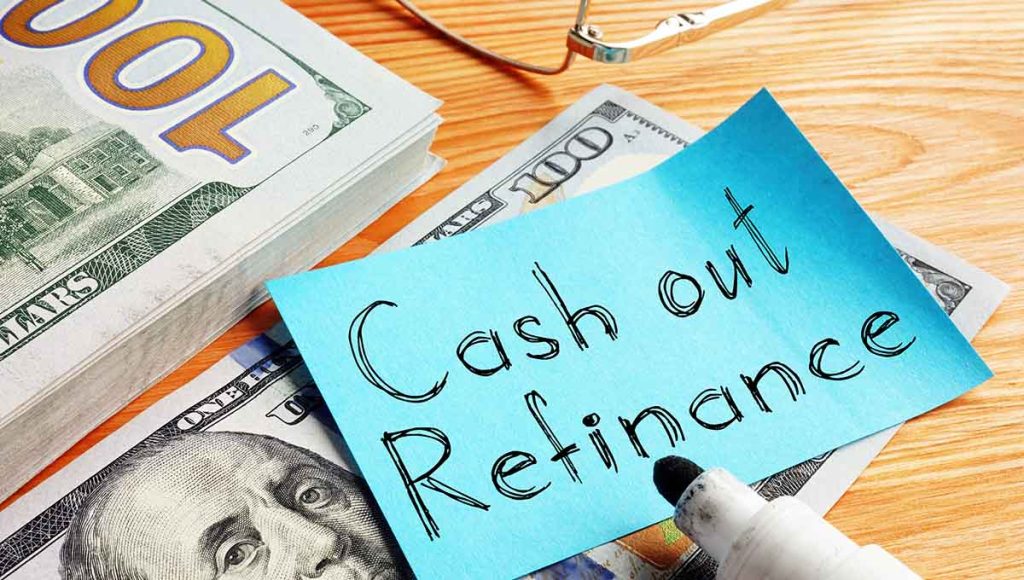
Are you sitting on a goldmine of home equity and dreaming of that perfect kitchen remodel or backyard oasis? Cash-out refinancing for home improvements might just be the key to turning your property dreams into reality. In this comprehensive guide, we’ll explore everything you need to know about leveraging your home’s value to fund your renovation projects.
What Is Cash-Out Refinancing?
Before we dive deep, let’s get our basics straight. Cash-out refinancing is a financial strategy that allows homeowners to refinance their existing mortgage for more than they currently owe and pocket the difference in cash. This extra cash can be used for various purposes, including home improvements.
For example, if your home is worth $300,000 and you owe $200,000 on your mortgage, you have $100,000 in equity. With cash-out refinancing, you could potentially borrow up to $240,000 (80% of your home’s value), pay off your existing $200,000 mortgage, and walk away with $40,000 in cash for your home improvement projects.
The Pros and Cons of Cash-Out Refinancing for Home Improvements
Like any financial decision, cash-out refinancing comes with its own set of advantages and disadvantages. Let’s break them down:
Pros:
- Lower interest rates: Compared to other financing options like personal loans or credit cards, cash-out refinancing often offers lower interest rates.
- Tax deductibility: In many cases, the interest paid on a cash-out refinance used for home improvements is tax-deductible (consult a tax professional for specifics).
- Increased home value: Strategic home improvements can significantly boost your property’s value.
- Single monthly payment: Unlike taking out a separate loan, cash-out refinancing keeps all your debt under one roof.
Cons:
- Increased debt: You’re essentially taking on more mortgage debt, which could be risky if your financial situation changes.
- Closing costs: Refinancing comes with closing costs, which can be substantial.
- Risk of foreclosure: Your home serves as collateral, meaning you could lose it if you can’t make payments.
- Potential for underwater mortgage: If property values decline, you could end up owing more than your home is worth.
Comparison Table: Cash-Out Refinancing vs. Other Home Improvement Financing Options
To help you make an informed decision, let’s compare cash-out refinancing with other popular financing options:
Feature | Cash-Out Refinance | Home Equity Loan | HELOC | Personal Loan | Credit Card |
|---|---|---|---|---|---|
Interest Rate | Generally lower | Fixed, slightly higher than cash-out refi | Variable, can be lower initially | Higher than secured loans | Highest |
Term Length | 15-30 years | 5-30 years | Draw period (5-10 years) + repayment period | 1-7 years typically | Revolving |
Tax Deductibility | Often deductible | Often deductible | Often deductible | Not deductible | Not deductible |
Closing Costs | Yes, can be substantial | Yes, but typically lower than cash-out refi | Yes, but typically lower than cash-out refi | Usually none or minimal | None |
Disbursement | Lump sum | Lump sum | As needed during draw period | Lump sum | As needed |
Effect on First Mortgage | Replaces existing mortgage | Separate from first mortgage | Separate from first mortgage | No effect | No effect |
Collateral Required | Yes (home) | Yes (home) | Yes (home) | Usually unsecured | Usually unsecured |
Is Cash-Out Refinancing Right for Your Home Improvement Project?
Now that we’ve laid out the basics, let’s dig into whether cash-out refinancing is the right choice for your specific situation. Here are some factors to consider:
- Equity in your home: Most lenders require you to maintain at least 20% equity in your home after the refinance. If you don’t have enough equity, this option might not be available to you.
- Credit score: A higher credit score will generally qualify you for better interest rates. If your credit score has improved since you got your original mortgage, you might be in a good position to benefit from cash-out refinancing.
- Debt-to-income ratio: Lenders typically look for a debt-to-income ratio of 43% or less. If taking on additional mortgage debt would push you over this threshold, you might want to explore other options.
- Long-term plans: If you’re planning to sell your home in the near future, the closing costs associated with refinancing might not be worth it. However, if you’re planning to stay put for a while, the potential savings from a lower interest rate could offset these costs over time.
- Current interest rates: If current rates are significantly lower than your existing mortgage rate, refinancing could save you money in the long run, even with the added cash-out amount.
- Size of your project: Cash-out refinancing is often best suited for larger home improvement projects. For smaller renovations, options like a HELOC or personal loan might be more appropriate.
Steps to Cash-Out Refinancing for Home Improvements
If you’ve decided that cash-out refinancing is the way to go, here’s a step-by-step guide to the process:
- Check your credit score: Your credit score will play a significant role in determining your interest rate. Check your score and address any issues before applying.
- Estimate your home’s value: Get a rough idea of your home’s current market value. You can use online tools or consult a local real estate agent.
- Calculate your equity: Subtract your current mortgage balance from your home’s estimated value to determine your equity.
- Shop around for lenders: Don’t settle for the first offer you receive. Compare rates and terms from multiple lenders to find the best deal. Websites like Bankrate or NerdWallet can be helpful for comparing offers.
- Gather necessary documents: You’ll typically need to provide recent pay stubs, tax returns, bank statements, and information about your current mortgage.
- Apply for the refinance: Once you’ve chosen a lender, submit your application along with the required documentation.
- Get an appraisal: The lender will typically require an appraisal to confirm your home’s value.
- Review and sign the documents: Once approved, carefully review all the loan documents before signing.
- Close on the loan: Attend the closing, sign the final documents, and receive your funds.
- Start your home improvement project: With cash in hand, you’re ready to begin your renovations!
Making the Most of Your Cash-Out Refinance
To ensure you’re using your cash-out refinance wisely, consider these tips:
- Prioritize projects with a high ROI: Focus on improvements that will add the most value to your home. According to Remodeling Magazine’s 2021 Cost vs. Value Report, some of the best returns come from replacing your garage door (94.5% ROI), adding manufactured stone veneer (92.1% ROI), and minor kitchen remodels (72.2% ROI).
- Get multiple quotes: Don’t settle for the first contractor you find. Get at least three quotes for your project to ensure you’re getting a fair price.
- Create a detailed budget: Plan out all aspects of your project, including materials, labor, and a contingency fund for unexpected expenses.
- Consider energy-efficient upgrades: Improvements that increase your home’s energy efficiency can lead to long-term savings on utility bills.
- Don’t over-improve: Be cautious about improvements that might price your home out of the local market. Research comparable homes in your area to ensure your improvements align with local standards.
Real-Life Success Stories
To give you a better idea of how cash-out refinancing can work in practice, let’s look at a couple of real-life examples:
- The Kitchen Remodel: Sarah and Mike from Denver, Colorado, used a cash-out refinance to fund a $50,000 kitchen renovation. They refinanced their $300,000 mortgage on a $400,000 home, taking out an additional $50,000. Not only did they get their dream kitchen, but they also lowered their interest rate from 4.5% to 3.25%, saving them money in the long run despite the increased loan amount.
- The Multi-Purpose Renovation: James from Atlanta, Georgia, leveraged a cash-out refinance to fund several home improvements at once. He took out $75,000 to replace his roof, update his HVAC system, and add a deck to his backyard. These improvements not only enhanced his quality of life but also significantly increased his home’s value when he sold it three years later.
Expert Opinions
Don’t just take our word for it. Here’s what some financial experts have to say about cash-out refinancing for home improvements:
“Cash-out refinancing can be a smart way to fund home improvements, especially in a low-interest-rate environment. However, it’s crucial to have a solid plan for the funds and to avoid over-leveraging your home.” – Jane Smith, Certified Financial Planner
“While cash-out refinancing can provide a lump sum at a potentially lower interest rate, homeowners should carefully consider the long-term implications of extending their mortgage term.” – John Doe, Housing Market Analyst
For more expert opinions and discussions, check out forums like Reddit’s r/personalfinance or Bigger Pockets.
FAQs About Cash-Out Refinancing for Home Improvements
To wrap up our comprehensive guide, let’s address some frequently asked questions:
- Q: How much can I borrow with a cash-out refinance?
A: Most lenders allow you to borrow up to 80% of your home’s value, minus your current mortgage balance. However, some government-backed loans may allow for higher loan-to-value ratios. - Q: Will cash-out refinancing affect my credit score?
A: Initially, you may see a small dip in your credit score due to the hard inquiry and new account. However, if you make payments on time, it could positively impact your score in the long run. - Q: Can I use the cash from a refinance for anything other than home improvements?
A: Yes, you can use the funds for various purposes, including debt consolidation, education expenses, or investing. However, using it for home improvements may offer tax benefits that other uses don’t. - Q: How long does the cash-out refinancing process typically take?
A: The process usually takes 30 to 45 days, similar to a standard mortgage refinance. However, it can vary depending on your lender and individual circumstances. - Q: Are there alternatives to cash-out refinancing for home improvements?
A: Yes, alternatives include home equity loans, home equity lines of credit (HELOCs), personal loans, and government-backed renovation loans like the FHA 203(k) loan.
In conclusion, cash-out refinancing can be an excellent tool for funding your home improvement projects, offering potentially lower interest rates and tax benefits. However, it’s crucial to carefully consider your financial situation, long-term goals, and the specifics of your renovation plans before proceeding. By doing your research, shopping around for the best rates, and using the funds wisely, you can turn your home improvement dreams into reality while potentially improving your overall financial picture.
Remember, every financial decision is personal, and what works for one homeowner may not be the best choice for another. Always consider consulting with a financial advisor or mortgage professional to discuss your specific situation and goals. Happy renovating!






